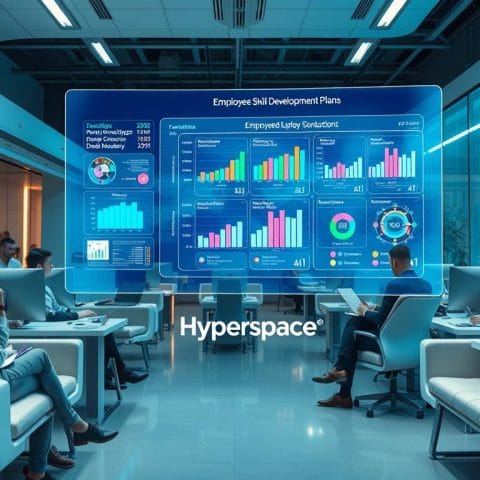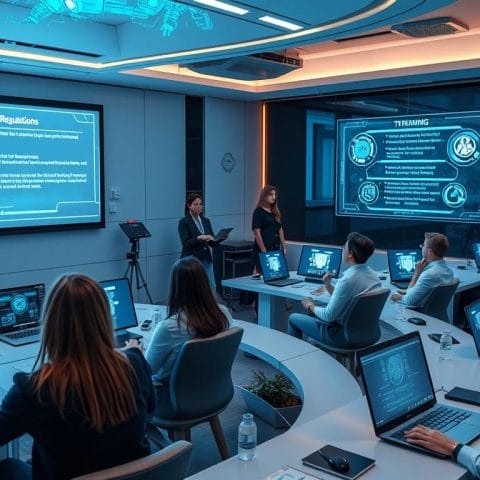In today’s fast-paced world, managing projects and leading teams is key. Hyperspace has created a new way to learn these skills. They use Artificial Intelligence (AI) and Virtual Reality (VR) to do it.
Hyperspace’s VR training program is changing how we learn project management. It uses the latest tech for a unique learning experience. You get personalized training, interactive simulations, and feedback in real time.
Key Takeaways
- AI-powered virtual training enables personalized learning paths, addressing individual needs and learning styles.
- Immersive simulations in the metaverse, enhanced by AI, offer realistic scenarios for practical skill development.
- AI promotes collaborative learning experiences in the metaverse, fostering teamwork, communication, and knowledge sharing.
- AI-driven VR training programs provide improved engagement, retention, cost-effectiveness, and accessibility for diverse audiences.
- The future of AI in virtual training programs includes advancements in AI capabilities and a focus on lifelong learning.
Understanding AI-Driven Project Management

The world of project management is changing fast, thanks to Artificial Intelligence (AI). AI is making old ways of working better. It gives project managers tools to work smarter, make decisions based on data, and automate simple tasks.
The Role of AI in Project Management
AI-driven project management starts with knowing the basics. This includes machine learning, natural language processing, and large language models. These technologies help project managers find insights in big data, make workflows smoother, and make better choices.
Benefits of Integrating AI Technology
- Improved Efficiency: AI tools can handle routine tasks, letting project managers focus on big ideas.
- Data-Driven Decision-Making: AI looks at past project data and other factors to help plan and predict.
- Enhanced Collaboration: AI helps teams talk and work together better with tools like chatbots.
Key AI Tools for Project Managers
- AI-Integrated Project Management Software: Makes managing tasks, schedules, and resources easier.
- Predictive Analytics Tools: Helps forecast project times, spot problems, and reduce risks.
- Robotic Process Automation (RPA): Automates simple tasks to save time and effort.
- Virtual Reality (VR) and Augmented Reality (AR) Applications: Offers a new way to plan and see projects.
AI in project management is a game-changer. It boosts traditional methods and opens up new ways to manage projects. This leads to better results and more efficient teams.
The Rise of Virtual Reality in Training

Virtual Reality (VR) is changing corporate training. It creates a simulated world where users can interact with digital elements. This makes learning fun and hands-on.
What is Virtual Reality (VR)?
VR takes you into a fake world made by computers. With a VR headset, you feel like you’re really there. You can touch and move around digital things.
The Advantages of VR for Skill Development
- Realistic Simulations: VR lets employees practice in a safe space. This boosts their skill and understanding.
- Personalized Learning: VR tracks how well each person is doing. It changes the training to fit each person better, saving time and money.
- On-the-Job Support: VR gives instant help and tips. This makes employees more productive and confident.
VR training makes learning real-world skills easier. It’s great for both technical and soft skills. With VR, companies can make their training better, leading to better employee performance and more work done.
| Benefit | Improvement |
|---|---|
| Learner Engagement | 400% increase |
| Retention Rates | 75% increase |
| Training Time | 60% decrease |
| Cost Savings | Up to $1 million annually |
As VR gets better, more companies will use it for training. This will change how we train workers. It will lead to better learning, more people staying, and better work done.
How AI Enhances VR Learning Experiences
AI and VR are changing how we learn and grow skills. AI makes VR training fit each learner’s needs. This creates a deep and changing learning experience.
Personalization of Training Modules
AI looks at each learner’s skills and how they like to learn. It then makes training that fits them perfectly. This makes learning more fun and helps people remember more.
Real-Time Feedback and Assessment
VR with AI gives feedback right away. It helps learners know what they need to work on. The AI makes sure the training gets harder or easier as needed.
AI and VR together make learning better. They help people learn in a way that’s fun, personal, and keeps getting better. This way of learning makes people more productive and successful.
“Opportunities to learn and grow” are the top-rated culture drivers worldwide, according to LinkedIn’s 2022 Workplace Learning Report.
Using AI and VR for training opens up new ways to learn. It lets people grow and succeed in a changing world.
Key Features of AI-Driven VR Training Programs
Organizations are now using AI and VR for project management training. These programs offer immersive, interactive simulations that mimic real-world scenarios. They go beyond just teaching, making learning fun and effective.
Interactive Simulations
Interactive simulations are at the core of these programs. They let users tackle complex project challenges safely. AI algorithms make these simulations change based on user actions.
This way, learners face many obstacles and decisions. They can practice skills like problem-solving and risk management. All without the risks of real-world mistakes.
Gamification Elements for Engagement
AI-driven VR programs also use gamification to keep learners engaged. They have systems to track progress, offer rewards, and show leaderboards. This makes learning a fun competition.
It taps into our natural drive to succeed. This approach makes learning both enjoyable and rewarding.
Collaborative Virtual Environments
These programs also focus on teamwork. They allow learners to work together in real-time. They practice communication and conflict resolution in a simulated setting.
The AI makes these collaborative features seamless. Learners can develop important soft skills along with their technical skills.
AI and VR together offer a new way to learn project management. Interactive simulations, gamification, and teamwork make it a powerful tool. It prepares both new and experienced managers for today’s challenges.
| Feature | Description | Benefits |
|---|---|---|
| Interactive Simulations | AI-powered virtual simulations that replicate real-world project scenarios | Allows for risk-free practice and development of critical skills like problem-solving and resource allocation |
| Gamification Elements | Progress tracking, rewards, and leaderboards to enhance engagement and motivation | Taps into the human desire for achievement, creating a dynamic and rewarding learning environment |
| Collaborative Virtual Environments | AI-enabled virtual spaces for team-based learning and practice of group dynamics | Develops essential soft skills like communication and conflict resolution alongside technical expertise |
These AI-driven VR training programs are changing how we learn project management. They combine interactive simulations, gamification, and teamwork. This prepares learners for the challenges of today’s projects.
Designing Effective AI-Driven VR Training Programs
Creating impactful AI-driven VR training programs starts with clear learning goals. These goals must match the key skills needed for project planning and execution. By focusing on the specific needs of each role, the training becomes more relevant and useful.
AI is key in designing these programs. It helps trainers use data to improve the training experience. This ensures the program stays up-to-date with new project management practices and technologies.
Identifying Learning Objectives
The base of a good AI-driven VR training program is clear learning goals. These goals should match the main skills project managers need. For example:
- Strategic planning and decision-making
- Risk management and mitigation
- Effective team collaboration and communication
- Adaptability and problem-solving
- Leveraging technology for enhanced productivity
By aligning the training with these skills, the program helps project managers handle the challenges of their roles.
Tailoring Content to Different Roles
Project management teams have many roles, each with its own tasks and challenges. AI-driven VR training programs need to be tailored for each role. For instance:
- Project Managers: Focus on strategic planning, risk management, and resource allocation
- Project Coordinators: Emphasis on task scheduling, stakeholder communication, and process optimization
- Project Analysts: Training on data analysis, forecasting, and reporting
- Project Specialists: Specialized training on technical aspects, such as agile methodologies or project management software
This tailored approach makes sure each trainee gets the most relevant and impactful learning experience. It helps them excel in their roles.
| Key Features | Benefits |
|---|---|
| Personalized Learning Paths | AI algorithms analyze user interactions and preferences to create customized training materials, tailored to individual needs. |
| Real-Time Feedback and Assessment | AI-driven analytics provide instant performance evaluations, enabling trainers to identify skill gaps and optimize resources efficiently. |
| Inclusive and Accessible Design | Real-time translation and accessibility features in AI enhance inclusivity, making VR training accessible to learners of diverse backgrounds. |
| Scalable and Cost-Effective | AI integration in VR environments allows for increased scalability of training programs across organizations, particularl in remote work settings, while reducing content development costs. |
“AI-powered virtual characters and non-player characters enhance training sessions by delivering realistic interactions, resulting in improved engagement and immersion for learners.”
Success Stories of AI-Driven VR Training in Project Management
AI-driven virtual reality (VR) training has changed the game in project management. Leading companies have seen big improvements. They’ve seen better project results, teamwork, and work flow.
Case Study: Verizon’s Customer Service Transformation
Verizon, a big name in telecom, used VR training to improve customer service. They trained call-center workers with AI-powered VR. This led to a 97% confidence boost among them, making customer interactions better.
Feedback from Trainees: Increased Confidence and Decision-Making Agility
People who’ve gone through AI-driven VR training love it. They say it makes them more confident and skilled at making decisions. Companies like GE Healthcare, Vodafone, and Johnson & Johnson have seen their teams get better at managing projects.
| Company | Benefit | Impact |
|---|---|---|
| GE Healthcare | Improved training availability and operational efficiency | Radiographers benefited from VR training |
| Vodafone | Enhanced presentation skills and performance | Positive feedback from employees |
| Johnson & Johnson | Increased learning efficacy for surgeons | VR training by Osso VR proved effective |
These stories show how AI-driven virtual reality training is changing project management. It’s making professionals better at their jobs, improving teamwork, and leading to better project results.
Overcoming Challenges in AI-Driven VR Training
Organizations are diving into AI-driven VR simulations for training project management skills. They face technical and user challenges. It’s key to tackle these to make these learning tools a success.
Technical Limitations and Solutions
Current VR tech has its limits. Issues like device compatibility, motion sickness, and AI algorithm updates can slow things down. But, tech keeps getting better:
- New hardware means better performance and visuals.
- Improvements in tracking and rendering cut down on motion sickness.
- AI gets smarter, making training more tailored and engaging.
User Adoption and Resistance
There’s also a human side to consider. Employees might be wary of new tech. Here’s how to win them over:
- Start slow with VR and AI training.
- Give users a solid onboarding to get them up to speed.
- Show how these tools improve skills and engagement.
By tackling tech and user hurdles, companies can make AI-driven VR training a success. This leads to better skills and a more skilled workforce.
Future Trends in AI and VR Training
Technology is always getting better, and AI and VR training are changing how we learn. AI and VR are making training more real, personal, and effective. This will change how we learn about project management.
Advancements in AI Technology
AI is getting smarter in VR training. It will understand us better, talk to us more clearly, and predict our performance. This means training will be more tailored to each person and more fun.
The Expanding Role of VR in Workplace Learning
The market for VR learning is growing fast, expected to hit $22 billion by 2026. VR is becoming easier to use, so it will be used more in project management training. People who learn through VR remember what they learn much better than others.
Also, the market for AI in VR training is expected to grow to $12 billion by 2025. Companies that use AI and VR training save a lot of money and time. They see big benefits from this new way of learning.
AI and VR training will soon be a big part of learning for project managers. It will make learning more fun, personal, and effective. As the world of work changes, using these new technologies will help companies stay ahead.
Getting Started with AI-Driven VR Project Management Training
To get the most out of AI-driven VR project management training, find a trusted provider like Hyperspace. They offer top-notch, tailored training programs. These programs are designed to meet your organization’s specific needs.
Selecting the Right Training Provider
When looking for a training provider, focus on those with a strong track record in AI-driven VR solutions. Check their offerings, expertise, and how well they fit into your workflows. It’s key to choose a provider that knows your industry and aligns with your goals.
Steps to Implementing the Training Program
After picking the right provider, plan how to roll out the training. Start by figuring out what your organization needs and what you want to achieve with the VR training. This ensures the training meets your goals, like better efficiency and faster project completion.
Then, work with your provider to pick the right VR hardware and fit the training into your workflows. You might need to provide support and make sure it works with your project management tools. By following these steps, you can boost your project management skills with AI-driven VR training.
FAQ
Q: What is AI-driven project management skills training in VR?
A: AI-driven project management skills training in VR is a new way to learn. It uses virtual reality and artificial intelligence. This method helps professionals lead teams better and get results.
It includes simulations, self-paced learning, and interactive role-playing. These tools improve project management skills.
Q: How does AI enhance traditional project management methodologies?
A: AI changes project management for the better. It teaches the basics of AI, machine learning, and more. This leads to better efficiency and smarter decisions.
AI also automates tasks, saving time and effort.
Q: What are the advantages of using VR for training and skill development?
A: VR training has many benefits. It offers realistic simulations and safe practice areas. This makes learning more engaging.
VR helps learners remember and apply what they learn. It’s great for all kinds of training, from soft skills to technical tasks.
Q: How does AI integrate with VR to create more personalized and effective learning experiences?
A: AI makes VR training better by making it personal. It adjusts the training to fit each learner’s needs. This means the content gets harder or easier as needed.
AI also gives feedback and creates new scenarios. This makes each training session unique and challenging.
Q: What are the key features of AI-driven VR training programs for project management?
A: These programs have interactive simulations and gamification. They make learning fun and engaging. They also have virtual environments for team practice.
Q: How do organizations design effective AI-driven VR training programs for project management?
A: Good programs start with clear goals. They match the training to different roles in project management. AI helps improve the training based on learner data.
Q: What are the success stories of implementing AI-driven VR training in project management?
A: Many companies have seen great results. They report better project outcomes and teamwork. Learners feel more confident and make better decisions.
They also understand complex project management concepts better.
Q: What challenges come with implementing AI-driven VR training, and how can they be addressed?
A: There are technical and user challenges. Solutions include improving hardware and software. Ensuring it works on different devices is also key.
Addressing motion sickness and showing the benefits helps with adoption.
Q: What are the future trends in AI and VR training for project management?
A: Future trends include better natural language processing and AI-human interaction. VR will play a bigger role in training. This will lead to more immersive and effective learning.
Q: How can organizations get started with implementing AI-driven VR project management training?
A: Start by choosing a reputable provider like Hyperspace. Assess your needs and define your goals. Choose the right VR hardware and integrate it into your workflow.
Provide support and resources for users during the transition.





